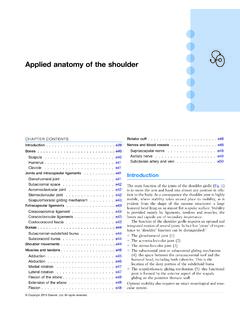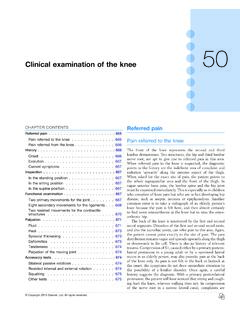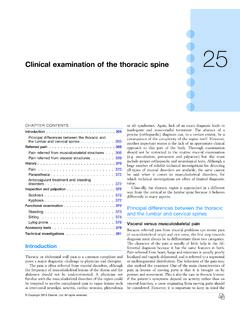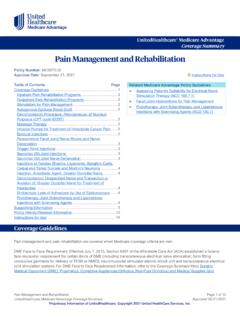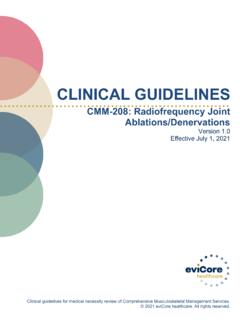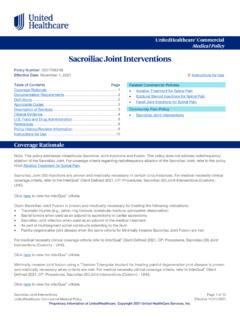Transcription of 41 - Clinical examination of the sacroiliac joint
1 Copyright 2013 Elsevier, Ltd. All rights Clinical examination of the sacroiliac jointCHAPTER CONTENTSI ntroduction ..595 Referred .pain ..596 Pain referred to the region of the sacroiliac joint .. 596 Pain referred from the sacroiliac joint .. 596 History ..596 Functional . examination ..596 Introduction .. 596 sacroiliac tests.. 597 Epidural .local .anaesthesia ..600 Radiology ..600 IntroductionSacroiliac arthritis, both rheumatic and septic, is a common cause of unilateral gluteal pain. The sacroiliac joint is a true synovial joint and therefore subject to the same inflammatory and infectious conditions that affect other synovial ,2 However, the sacroiliac joint as a primary source of mechanical backache remains controversial and diagnoses such as sacro iliac dysfunction or sacroiliac subluxation are ill defined and difficult to 5 Much of the controversy is caused by lack of agreement on Clinical criteria that justify the diag nosis of sacroiliac lesions.
2 If the diagnosis is made only on the basis of pain localization or tenderness on palpation, sacroiliac lesions will be seen frequently. If the diagnosis is based on a thorough Clinical examination of lumbar spine and pelvis, sac roiliac lesions will be rare. Unilateral pain and tenderness in the region of the sacroiliac joint is usually a manifestation of the confusing phenomena of referred pain and referred tenderness from a dura mater at a low lumbar level and not a reliable Clinical proof of a sacroiliac 9 Furthermore, mechanical testing of the sacroiliac joints exerting tension on the sacroiliac ligaments without affecting the lumbar spine and the hip joint is not easy.
3 Most commonly used tests lack this requirement, which may explain the differences of opinion between 12A discussion of the disorders affecting the joint requires definition of the following terms: sacroiliac strain/sprain is overstretch or rupture of the capsuloligamentous structures as a result of abnormal joint movement. sacroiliac instability is a condition of abnormal joint mobility caused by capsuloligamentous laxity. sacroiliac subluxation is permanent displacement of the bony parts forming the joint . sacroiliac dysfunction is a reversible decreased mobility of the joint , the result of articular causes.
4 sacroiliac arthritis is an inflammatory condition of the concept of a sacroiliac sprain as a common cause of backache and sciatica was introduced by Goldthwait and Osgood in 1905 and reinforced by ,14 It still persists. However, MacNab8 noticed that sacroiliac sprains only occur below the age of 45 and in circumstances creating considerable force on the joint , such as those generated by falls from a height or motor vehicle accidents. Cyriax7 (his p. 364) advised reserving the term for cases of pain arising from the sacroiliac ligaments in the absence of arthritis.
5 However, difficulty arises in those examples of early sacroiliitis in which pain and Clinical signs precede the appearance of radiographic can also be suggested by negative findings. For example, absence of articular signs in the lumbar spine, full range on straight leg raising, a normal end feel to the hip joint and the absence of neurological and arterial signs suggest pos sible involvement of the sacroiliac joint , when there is pain in the buttock, posterior thigh and sacroiliac joint and Coccyx596a disc lesion is present at a low lumbar level. However, if such a lesion is present, pain is normally felt in the lumbar area rather than the authors describe the adoption of an antalgic gait in painful disorders of the sacroiliac joint27,28 and a tilt of the trunk, most frequently towards the painless Some patients avoid sitting on the buttock of the affected symptoms, such as paraesthesia, weakness or numbness, are examinationIntroductionClinical examination of the sacroiliac joint is not routinely undertaken in low back pain and sciatica, except for one test sacroiliac distraction (see Fig.)
6 Below) because this is the most sensitive test to detect inflammation in the from the positive sacroiliac distraction test, attention may be drawn to the sacroiliac joint by some discrepancies between gross symptoms and slight signs during standing lumbar movements. For example, in acute sacroiliac arthritis, Clinical assessment does not differ from that described for the lumbar spine in low back pain disorders (see Ch. 36). When data from the history and functional examination suggest the possibility of a sacroiliac lesion, special tests can be per formed and additional imaging studies painIn sacroiliac joint lesions, pain may be either localized or referred to the buttock and leg.
7 The distinction between pain referred to and from the joint is very important and should be the first referred to the region of the sacroiliac jointMost instances are the result of lumbar disc protrusions with segmental (L1, L2, L3 and S1, S2) or multisegmental (lumbar dural) reference of pain. Arthritis of the hip joint is another possibility: pain may be felt in the inner and upper part of the buttock because of segmental reference of this joint in the third lumbar segment (see p. 11).Pain referred from the sacroiliac joint16 The innervation of the sacroiliac joint and its ligaments is wide and Studies confirm that the anterior portion of the joint is innervated by the ventral rami of L5, S1 and S2, and the dorsal portions of the joint by the dorsal ramus of L5 and a plexus derived from the dorsal rami of the sacral 20 The superior part of the joint and the iliolumbar ligaments have an L2 and L3 sacroiliac strain or arthritis, pain is most often felt in the buttock.
8 With radiation to the back of the thigh and the calf but never the foot. Often there is groin pain A typical distribution of pain is shown in Figure taking should cover preceding disease, trauma, preg nancy and delivery, occupation and working habits, as well as sports and recreational activities. Family and social history are of similar In pelvic peripartum instability, the pain often starts in the third month or within the first few weeks after sacroiliac lesions, a typical finding is that there is unilat eral gluteal pain (often deep, dull and ill defined24 26), perhaps together with reference to the S1 S2 dermatomes, chiefly the posterior thigh.
9 Pain may alternate in the right and left but tocks which strongly suggests a manifestation of early ankylos ing spondylitis, particularly when it is found in males aged between 15 and usually jars the buttock or posterior thigh as the result of the sudden increase in abdominal pressure which distracts the ilium from the sacrum. This sign may be inter preted as being of dural origin, based on the assumption that Fig Pain referred from the sacroiliac joint . (a) Pain in the groin may refer from the superior part of the joint . (b) Typical pain referred from the posterior capsule and ligaments.
10 (a)(b)CHAPTER 41 Clinical examination of the sacroiliac joint597 Pain .provocation .testsPain provocation tests aim to stress the structures in an attempt to reproduce the patient s symptoms. Studies that have exam ined these tests show good interexaminer 39 The main tests are: Distraction test or anterior gapping test Compression test or posterior gapping test Sacral thrust or downward pressure test Cranial shear test Posterior shear or thigh trust test Pelvic torsion or Gaenslen s test Yeoman test Patrick s or faber gapping test (Fig. )This test, always performed routinely in the basic functional examination of the lumbar spine, has a high sensitivity and an almost 100% specificity for sacroiliac ,41full trunk flexion and side bending to the painful side may provoke pain, but the pain becomes much more severe as soon as the sacroiliac joints are directly tested.
